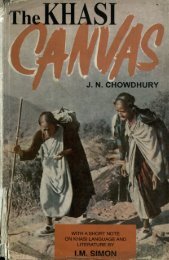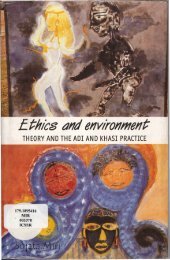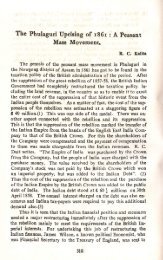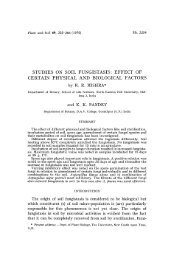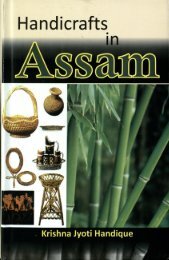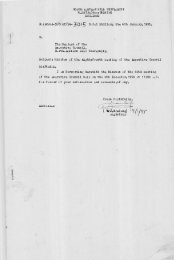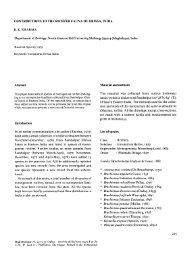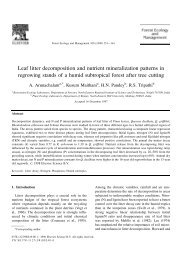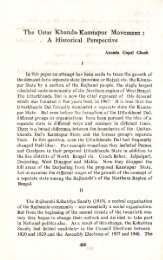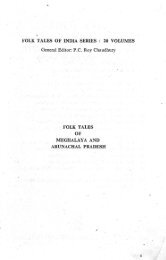Violence n Identity in NE.pdf - DSpace@NEHU
Violence n Identity in NE.pdf - DSpace@NEHU
Violence n Identity in NE.pdf - DSpace@NEHU
Create successful ePaper yourself
Turn your PDF publications into a flip-book with our unique Google optimized e-Paper software.
THE AUTHOR<br />
SR TOHRING (b 1975), did her early school<strong>in</strong>g <strong>in</strong> Manipur at United<br />
Pentecostal School, Ravalon School, Analon Christian Institute and<br />
Chakpikarong Government High School and later on she did her<br />
Intermediate from Union Christian College, Shillong. She graduated<br />
from Gargi .College, Delhi University, Delhi and obta<strong>in</strong>ed her Master's<br />
Degree <strong>in</strong> Modern Indian History from Jamia Millia Islamia University,<br />
New Delhi. She persuaded for her M.Phi!. and later on did her Ph.D.<br />
from Jawaharlal Nehru University, New Delhi.<br />
She has written extensively on the themes of tribes, ethnic groups and<br />
ethnic conflicts and has been published <strong>in</strong> various newspapers,<br />
journals, and edited book.
VIOLENCE<br />
AND<br />
IDENTITY<br />
IN<br />
NORtH-EAST INDIA<br />
Naga-Kuki Conflict<br />
SR TOHRING<br />
MMITTAL<br />
PU8L1CI\TIONS<br />
MITTAl PUBLICATIONS<br />
<strong>NE</strong>W DELHI (INDIA)
No part of this work may be reproduced, stored <strong>in</strong> a retrieval system, or transmitted<br />
<strong>in</strong> any form or by any means, electronic, mechanical photocopy<strong>in</strong>g, record<strong>in</strong>g or<br />
otherwise, without the prior written permission of the copyright owner and the<br />
publisher.<br />
First Published 2010<br />
©SRTohr<strong>in</strong>g<br />
All rights reserved<br />
ISBN 81-8324-344-4<br />
Published and pr<strong>in</strong>ted by Krishan Mittal for Mittal Publications<br />
4594/9, Daryaganj, New Delhi - 110002, India.<br />
Phone: 23250398, 25351493 Telefax: 91-11-25351521<br />
e-mail: mittalp@ndf.vsnl.net.<strong>in</strong>/<strong>in</strong>fo@mittalbooks.com<br />
Website : www.mittalbooks.com
~~ fAJ/ -------..<br />
My lov<strong>in</strong>g parents SR Tourngam and PY Shanglun and<br />
to all the <strong>in</strong>nocents who have lost their lives <strong>in</strong> the<br />
Kuki-Naga clashes
Introduction<br />
Abbreviations<br />
List of Tables<br />
CONTENTS<br />
xi<br />
xxiii<br />
1. ETHNIC IDENTITIES 1<br />
1.1 Explanations of the Terms '<strong>Identity</strong>' and 'Ethnic' 1<br />
1.2 Def<strong>in</strong>itions of Ethnic <strong>Identity</strong> 2<br />
1.3 Approaches of Ethnic <strong>Identity</strong> 4 .<br />
1.4 Ethnic Identities of the Nagas and the Kukis 5<br />
1.4.1 The Term 'Naga' 6<br />
1.4.2 The Term 'Kuki' 8<br />
1.4.3 Classification of the Nagas and the<br />
Kukis as Separate Ethnic Entities 9<br />
1.4.4 Ethnic <strong>Identity</strong> of the Nagas 11<br />
1.4.5 Ethnic <strong>Identity</strong> of the Kukis 15<br />
1.4.6 Comparison between the Nagas and<br />
the Kukis 23<br />
2 ETHNIC MOVEMENTS 29<br />
2.1 The Naga Movement 31<br />
2.1.1 Underground Organizations of the Nagas 37<br />
2.1.2 Civil Organizations of the Nagas 40<br />
2.2 The Kuki Movement 43<br />
2.2.1 Civil Organizations of the Kukis 43<br />
2.2.2 Underground Organizations of the Kukis 46<br />
3. HISTORICAL BACKGROUND, POLITICAL, RELIGIOUS<br />
AND SOCIO-ECONOMIC RELATIONS, 1826-1990 53<br />
3.1 A Brief Review of their Historical Background of<br />
the Ethnies 53
viii / <strong>Violence</strong> and <strong>Identity</strong> <strong>in</strong> North-East India<br />
3.2 Political Relationship of the Nagas and the Kukis 57<br />
3.2.1 Relations on the Eve of British Rule 57<br />
3.2.2 Relations dur<strong>in</strong>g the British Era 60<br />
3.2.3 Relations on the Eve and after India's<br />
Independence 62<br />
3.2.4 Relations <strong>in</strong> their Civil Movements <strong>in</strong> Post-<br />
Independent Era 66<br />
3.2.5 Relations <strong>in</strong> Underground Movements<br />
after India's Independence 68<br />
3.3 The Naga-Kuki Relations <strong>in</strong> the Religious Sphere 71<br />
3.3.1 Animism and the Naga-Kuki Relations 72<br />
3.3.2 Christianity and the Naga-Kuki Relations 74<br />
3.4 The Economic Ties between the Nagas and the<br />
Kukis 81<br />
4. ETHNIC CONFLICT OF 19905 91<br />
4.1 Usage of the Terms: 'Ethnic Cleans<strong>in</strong>g', 'Genocide',<br />
'Communal Clash', 'Ethnic Conflict' 92<br />
4.2 Views on the Naga-Kuki Violent Ethnic Conflict 96<br />
4.2.1 The Government's View 96<br />
4.2.2 The Meeteis' View 98<br />
4.2.3 The All Tribal Students' Union Manipur<br />
(ATSUM) 99<br />
4.2.4 The Nagas' View 100<br />
4.2.5 The Kukis' View 101<br />
4.3 The Causes of the Naga-Kuki Violent Ethnic<br />
Conflict 103<br />
4.3.1 Government 104<br />
4.3.2 Ethnic <strong>Identity</strong> 107<br />
4.3.3 Ethnic Movement 109<br />
4.3.4 Land 110<br />
4.3.5 Taxation 113<br />
4.3.6 Control of Moreh Town and National<br />
Highway 39 (Pallel-Moreh) 116<br />
4.3.7 The State of Manipur's Response 118
Contents I ix<br />
5. CHANGING NATURE-1990S 129<br />
5.1 Events Lead<strong>in</strong>g to the Naga-Kuki Violent Conflict 129<br />
5.2 Naga-Kuki Clashes 132<br />
5.3 Proliferation of the Naga-Kuki <strong>Violence</strong> 135<br />
5.4 Nature of the Naga-Kuki Violent Conflict 143<br />
5.5 Role and Position of Armed Forces 154<br />
6. THE PROCESS OF TRANSFORMATION AND<br />
RESTORATION OF NORMALCY 167<br />
6.1 A Brief Review of the Early Events and Early<br />
Peace Initiatives 168<br />
6.2 Government's Role <strong>in</strong> the Peace Process 169<br />
6.3 Role of Committee for the Restoration of Normalcy<br />
~RN) 1~<br />
6.4 Role of the Tribal Communities for Peace 179<br />
6.4.1 Role OfAll Tribal Students' Union,<br />
Manipur (ATSUM) 179<br />
6.4.2 Role of the Tribal Leaders 181<br />
6.4.3 Role of Tribal's Politicians, Lawyers and<br />
Students 182<br />
6.4.4 All Tribal Women's Association of Manipur 184<br />
6.4.5 The Naga Women's Union of Manipur and the<br />
Kuki Women's Organization 184<br />
6.4.6 Regional Peace Initiatives 185<br />
6.5 The Church's Role <strong>in</strong> the Peace Process 188<br />
6.6 Militants' Role <strong>in</strong> Achiev<strong>in</strong>g Peace 191<br />
7. CONCLUSION 197<br />
Bibliography 207<br />
Index 217
INTRODUCTION<br />
cgthnicity, as we know it today, emerged after the Second<br />
World War, though the term ethnicity existed prior to the<br />
11 World War. Soon, the study on the ethnicity ga<strong>in</strong>ed<br />
momentum, particularly s<strong>in</strong>ce the 1960s. Dennes L.Ttiompson says:<br />
"the term ethnicity has replaced the terms like Nationality, National<br />
group<strong>in</strong>g and M<strong>in</strong>ority." In India, there are many ethnic entities;<br />
some have launched ethnic movements with an armed w<strong>in</strong>g, while<br />
others launched ethnic movements which do not <strong>in</strong>volve armed<br />
clashes. Of course, there are also ethnic entities with no movements.<br />
In ethnic movements with or without arms the North-East region of<br />
India is one of the most conspicuous regions. Yet "rarely do North-<br />
Eastern issues make it to the front page, quite unlike the treatment<br />
given by the national press to similar unrests <strong>in</strong> other parts of the<br />
country. Verily, the region is geographically and even otherwise at<br />
the periphery of the National consciousness.'? As a result of this<br />
apathy, the knowledge about North-East region is poor among the<br />
population of the rest of the country. This is one reason why the<br />
ethnic movements like that of the Nagas is least known, despite, it<br />
be<strong>in</strong>g christened as the longest movement. The ethnic clashes <strong>in</strong><br />
North-East after India's <strong>in</strong>dependence are, at times, worse than any<br />
of the bloody clashes <strong>in</strong> the rest of the country <strong>in</strong> terms of brutality,<br />
heavy toll on <strong>in</strong>nocent human lives, properties, and span of conflicts<br />
but mostly they went unnoticed. This apathy could be seen <strong>in</strong> Naga-<br />
Kuki violent ethnic conflict which will be discussed <strong>in</strong> the ma<strong>in</strong><br />
chapters. Pranay Sharma compla<strong>in</strong>s <strong>in</strong> a newspaper <strong>in</strong> regard to<br />
<strong>in</strong>difference on Naga-Kuki violent conflict.<br />
"The spate of kill<strong>in</strong>gs of <strong>in</strong>nocent Kukis and Nagas by <strong>in</strong>surgents<br />
<strong>in</strong> Manipur reveals the absence of a comprehensive government<br />
policy for the regions and shows how removed the North-East is<br />
from the National Consciousness. S<strong>in</strong>ce last October, when ethnic<br />
clashes between Kukis and Nagas first broke out, over 1,000 people<br />
have been killed, but precious little had been done by the Union<br />
Government to br<strong>in</strong>g the situation under control. Neither has the<br />
opposition exerted pressure on the center to tackle the turmoil <strong>in</strong>
xii / <strong>Violence</strong> and <strong>Identity</strong> <strong>in</strong> North-East India<br />
the North-East mean<strong>in</strong>gfully. Observers feel that this lack of attention<br />
shows that the region is not one of the nation's top priorities. The<br />
centre's responses to problems <strong>in</strong> the North-East has been<br />
characterized by knee-jerk reactions and short-term solutions though<br />
47 years have passed s<strong>in</strong>ce <strong>in</strong>dependence, no effort has been made<br />
to evolve a policy that would takes care of the special need of the<br />
region. The problems of the North-East are not merely political but<br />
also cultural, social, l<strong>in</strong>guistic and economic <strong>in</strong> nature."<br />
The North-East region has seven states connected to the<br />
'ma<strong>in</strong>stream' India <strong>in</strong> a long 14 km and 30 km wide neck and share<br />
<strong>in</strong>ternational boundaries with Ch<strong>in</strong>a, Bhutan, Myanmar, and<br />
Bangladesh. Historicaliy, pockets of Assam were known to some<br />
'ma<strong>in</strong>stream' rulers of India and later on, erstwhile pr<strong>in</strong>cely states<br />
like Manipur came to have some l<strong>in</strong>k with 'ma<strong>in</strong>stream' India which<br />
was prior to the advent of the British rule. However, the rest of the<br />
areas were unknown areas and were occupied by various tribes like<br />
the Nagas. With the advent of British rule, this situation came to<br />
be altered. The treaty of Yandabo <strong>in</strong> 1826 between British rulers<br />
and Burma, besides others, is remarkable as it paved the way for<br />
the British rulers to conquer some (approx.1/3) of the tribes' areas,<br />
and to claim the rest of unconquered areas as theirs, though their<br />
adm<strong>in</strong>istration did not extend over to these unconquered areas.<br />
Furthermore, pr<strong>in</strong>cely state like Manipur also came to be under the<br />
<strong>in</strong>fluence of the colonialists.<br />
When India got Independence, it <strong>in</strong>herited the areas enclosed<br />
by colonial boundaries. In the North-East, the pr<strong>in</strong>cely k<strong>in</strong>gdoms<br />
and the ethnic entities were persuaded to jo<strong>in</strong> the Indian Union by<br />
sign<strong>in</strong>g '<strong>in</strong>strument of accession'. However, many of them refused<br />
to sign it. Nevertheless, gradually all of them were persuaded by<br />
fair or foul means to sign it; the Mizos jo<strong>in</strong>ed Indian Union voluntarily<br />
as it was perceived a sort of social compulsion dur<strong>in</strong>g that period.<br />
The Khasis signed the'<strong>in</strong>strument of accession' although there was<br />
opposition from with<strong>in</strong>. In the case of the Nagas, they refused to<br />
jo<strong>in</strong> the Indian Union, thus, 'Hydari agreement' was signed on 26th<br />
June, 1947. Till date, this agreement rema<strong>in</strong>s a bone of contention<br />
between the Indian government and the Nagas. The Pr<strong>in</strong>cely states<br />
like Tripura and Manipur signed the '<strong>in</strong>strument of accession' <strong>in</strong><br />
1949. Thus, by 1949, the North-East region came to be considered<br />
as a part of the Indian Union, which completed India's <strong>in</strong>heritance<br />
of colonial boundaries <strong>in</strong> North-East. However, today, most of ethnic<br />
entities <strong>in</strong>clud<strong>in</strong>g those <strong>in</strong> pr<strong>in</strong>cely states question the '<strong>in</strong>strument<br />
of accession".
Introduction / xiii<br />
Today, many ethnic entities <strong>in</strong> the North-East have launched<br />
movements aga<strong>in</strong>st the Government of India. These movements<br />
could be classified, keep<strong>in</strong>g <strong>in</strong> m<strong>in</strong>d the Indian Constitution, <strong>in</strong>to<br />
three types: constitutional, non-constitutional, and a mixture of the<br />
two. The demands of these movements' fall under the follow<strong>in</strong>g<br />
categories: (a) Sovereignty; (b) Autonomy with<strong>in</strong> the framework of<br />
the nation-state of India and (c) ethnic rights, recognition, preservation<br />
and promotion, etc. The method they adopt to achieve these goals<br />
are violent or non violent or both, which consequently means nonconstitutional<br />
or constitutional or both.<br />
Most of the ethnic groups <strong>in</strong> North-East India consider the Indian<br />
rule as the same as British colonialism. Therefore, ethnic<br />
movements, many of them, are aimed to free themselves from Indian<br />
colonialism. The ethnic groups like the Nagas claim that, they never<br />
signed any agreement to be part of Indian Union, and therefore, it<br />
is an 'imposed government'. Secondly, for those ethnic entities<br />
regarded as the ones who agreed to be part of Indian Union,<br />
question over the sign<strong>in</strong>g of the '<strong>in</strong>strument of accession' to the<br />
Indian union. They considered that it was done by forceful and<br />
fraudulent means. Further, there are also ethnic entities that went<br />
unnoticed dur<strong>in</strong>g the sign<strong>in</strong>g of the'<strong>in</strong>strument of accession', and<br />
have launched movements for realiz<strong>in</strong>g the aforementioned goals.<br />
Some of the ethnic movements <strong>in</strong> the North-East India began<br />
their activitiesdur<strong>in</strong>g colonial era, while others did so on the eve of<br />
India's <strong>in</strong>dependence, or after India <strong>in</strong>dependence. Today, many of<br />
these movements <strong>in</strong> North-East are labeled as '<strong>in</strong>surgencies' which<br />
means 'ris<strong>in</strong>g <strong>in</strong> revolt aga<strong>in</strong>st an established civil authority'.' it is<br />
<strong>in</strong>cumbent for us to understand the significance of the term<br />
'<strong>in</strong>surgency' while referr<strong>in</strong>g to the various political movements that<br />
took place dur<strong>in</strong>g the British period and which are tak<strong>in</strong>g place ever<br />
s<strong>in</strong>ce India's <strong>in</strong>dependence. The question before us is: whether the<br />
leaders of these movements call themselves <strong>in</strong>surgents ... we may<br />
surmise how they would call themselves: fr~edom fighters, patriots,<br />
liberators, or defenders of their nation, faith and culture, ..All of them<br />
did not regard themselves as '<strong>in</strong>surgents'. They all talked about their<br />
country, nation, identity, faith and culture <strong>in</strong> the sense of be<strong>in</strong>g a<br />
Naga, a Manipuri, or a Mizo. An attempt to preserve one's identity<br />
does not necessarily mean that he is an <strong>in</strong>surgent nor does an<br />
attempt to preserve one's <strong>in</strong>dependence, from the National Socialist<br />
Council of Nagaland (NSCN) po<strong>in</strong>t of view, amounts to <strong>in</strong>surgency.<br />
It therefore depends on how the concerned parties look at the<br />
problem."
xiv I <strong>Violence</strong> and <strong>Identity</strong> <strong>in</strong> North-East India<br />
The major movements <strong>in</strong> the North-East till date are:<br />
. 1. The Nagas movement;<br />
2. The Assamese movement;<br />
3. The Bodos movement;<br />
4. The Damasas movement;<br />
5. The Karbis movement;<br />
6. The Meeteis movement;<br />
7. The Kukis movement;<br />
8. The Hmars movement; and<br />
9. The Khasis movement.<br />
There are several other movements but the preced<strong>in</strong>g ones<br />
mentioned are some of the major movements. S<strong>in</strong>ce years, these<br />
movements <strong>in</strong> North-East forge alliances to fight jo<strong>in</strong>tly aga<strong>in</strong>st the<br />
Indian government to achieve their goals. In recent years, alliances<br />
and unity have become prom<strong>in</strong>ent features for the ethnic movements<br />
<strong>in</strong> North-East India. Accord<strong>in</strong>g to B. Pakem, on 22 May, 1990 Indo-<br />
Burma Revolutionary Front of the NSCN (K), ULFA, and UNLF was<br />
formed. In late 1993, the United Liberation Front of the Seven Sisters<br />
(ULFSS) was formed under the leadership of the NSCN-IM, and on<br />
November 30, 1994 Self-Defense United Front of South-East<br />
Himalaya Region (SDUFSEAHR) with 23 representatives was<br />
formed under the leadership of NSCN-IM6 In 1994, The North-East<br />
Indigenous and Tribal Peoples Forum was established after the<br />
International Year of Indigenious Peoples <strong>in</strong> 1993. It was reported<br />
<strong>in</strong> a newspaper: "Extraneous agencies seem to be work<strong>in</strong>g <strong>in</strong><br />
tandem with the National Socialist Council of Nagaland to forge<br />
alliance between all the secessionist and separatist ethnic<br />
movements through the apparently <strong>in</strong>nocuous mobilization of<br />
"<strong>in</strong>digenous peoples" <strong>in</strong> the North-East. A common feature that has<br />
been discerned is the plea for right to self-determ<strong>in</strong>ation for all<br />
<strong>in</strong>digenous and tribal people. The <strong>in</strong>spiration evidently hav<strong>in</strong>g come<br />
from the U N draft declaration on the Rights of Indigenous People."?<br />
The U.N. def<strong>in</strong>es the <strong>in</strong>digenous peoples as descendants of<br />
people who <strong>in</strong>habited the present territory of a country, wholly or<br />
partially, ata time when persons of a different culture or ethnic orig<strong>in</strong><br />
arrived from other parts of the world, overcame them, by conquest,<br />
settlement, or other means, and reduced to non-dom<strong>in</strong>ant or colonial<br />
condition. The U.N. seeks to provide right to self-determ<strong>in</strong>ation to<br />
the <strong>in</strong>digenous people so as to enable them to determ<strong>in</strong>e their own
Introduction /xv<br />
political status and <strong>in</strong>stitutions. India along with some other<br />
countries <strong>in</strong>clud<strong>in</strong>g the USA is opposed to this, as this right will<br />
legitimize secession, encourage terrorism and lead to dis<strong>in</strong>tegration<br />
of States" For the North-East,"the North-east Indigenous and Tribal<br />
Peoples Forum <strong>in</strong> its convention at Guwahati <strong>in</strong> September,1994<br />
welcomed the U.N. draft declaration, <strong>in</strong>clud<strong>in</strong>g their right to self<br />
determ<strong>in</strong>ation."9 At the 12th session of the United Nations Work<strong>in</strong>g<br />
Group of Indigenous Populations (UNWGIP) <strong>in</strong> Geneva, held from<br />
July 25 to 29, 1994 five prom<strong>in</strong>ent tribal leaders of India, authorized<br />
to present their case by the various tribal orqanizations <strong>in</strong> the<br />
country, said that the right of self-determ<strong>in</strong>ation was now considered<br />
a fundamental human right without which no other human rights<br />
could be enjoyed.'?<br />
Before we go deep <strong>in</strong>to the study, I would like to <strong>in</strong>troduce the<br />
Nagas and the Kukis. The Nagas are found both <strong>in</strong> India and<br />
Myanmar. In Myanmar, they are settled <strong>in</strong> Saga<strong>in</strong>g division and<br />
Kach<strong>in</strong> state and <strong>in</strong> India, accord<strong>in</strong>g to the List of Schedule Tribes<br />
of India, they are <strong>in</strong> the states of Nagaland, Assam, Manipur,<br />
Arunachal Pradesh, Meghalaya and Mizoram. In these states except<br />
Manipur, they are recognized as 'Any Naga tribes'. In the state of<br />
Manipur, accord<strong>in</strong>g to Tribes In Manipur At A Gience," al: the tribes<br />
could be divided <strong>in</strong>to Naga Group of tribes, Ch<strong>in</strong>-Kuki-Mizo Groups<br />
of tribes and Intermediate Group of tribes. However, <strong>in</strong> reality most<br />
of the tribes of the <strong>in</strong>termediate group are Nagas.Therefore, <strong>in</strong><br />
Manipur, there are n<strong>in</strong>eteen (19) Naga tribes. Accord<strong>in</strong>g to Naga<br />
Hoho, the total geographical areas occupied by the Nagasis<br />
1,00,000 sq.krn." This total geographical area of the Nagas <strong>in</strong>cludes<br />
the areas of Nagas <strong>in</strong> India and Myanmar. In India, accord<strong>in</strong>g to<br />
Wetshokhrolo Lasuh, Naga-<strong>in</strong>habited states <strong>in</strong> India are: Arunachal<br />
Pradesh, Assam, Manipur, and Nagaland. There are eight districts<br />
with<strong>in</strong> Nagaland state, viz., Phek, Mokokchung, Kohima, Tuesang,<br />
Wokha, Mon, Zunheboto, and Dimapur. In Manipur, Naga-<strong>in</strong>habited<br />
districts are: Tamenglong, Senapati, Chandel, and Ukhrul. In<br />
Arunachal Pradesh, Naga-<strong>in</strong>habited districts are Chanflang and Tirap.<br />
In Assam, Naga-<strong>in</strong>habited districts are Haflong and Diphu." These<br />
areas are the claim of Nagas for sovereignty. The total population<br />
of the Nagas <strong>in</strong> both countries is estimated as 3.5 millions.<br />
The Naga tribes both <strong>in</strong> India and Myanmar are:<br />
1. Anal 2. Angami 3. Aa<br />
4. Chakhesang 5. Chang 6. Cheril<br />
7. Chirr 8. Chiru 9. Cholhe
xvi / <strong>Violence</strong> and <strong>Identity</strong> <strong>in</strong> North-East India<br />
10. Hemi 11. Hewa 12. Htangan<br />
13. Inpui 14. Konyak 15. Khiamnungam<br />
16. Kharam Khaklak/Hkaklak 17. Koireng 18. Kayo<br />
19. Khaklak/Hkaklak 20. Kengu 21. Lamkang<br />
22. Liangmai 23. Laihe 24. La<strong>in</strong>ung<br />
25. Lotha 26. Maram 27. Mao<br />
28. Mar<strong>in</strong>g 29. Moyon 30. Monsang<br />
31. Macharay/Makury/Makhori 32. Malang 33. Nokho/Noko<br />
34. Nokte 35. Nolang 36. Namshik<br />
37. Pakang 38. Phellongri 39. Phom<br />
40. Phochuri 41. Phango 42. Phankem<br />
43. Pangmi 44. Pangu 45. Para<br />
46. Poumai 47. Rangpan 48. Rasit<br />
49. Rekho 50. Rengma 51. Rongmei<br />
52. Sangtam 53. Saplo 54. Shangphuri<br />
55. S<strong>in</strong>gpho 56. Sira 57. Somi<br />
58. Sumi 59. Tarao 60. Tangkhul<br />
61. Thangal 62. Tangsa 63. Tikhir<br />
64. Wanchao 65. Yimchunger 66. Zerne."<br />
Thus, the total number of Naga tribes is sixty-six (66). However,<br />
besides, the above mentioned Naga tribes, there are many<br />
unrecognized Naga tribes, which are not listed above. Out of these<br />
sixty-six (66) Naga tribes listed above, there are about thirty-six<br />
(36) Naga tribes <strong>in</strong> India:<br />
1. Anal 2. Angami 3. Ao<br />
4. Chakhesang 5. Chang 6. Chiru<br />
7. Chothe 8. Hewa 9. Inpui<br />
10. Khiamnungam 11. Konyak 12. Koireng<br />
13. Lamkang 14. Liangmai 15. Lotha<br />
16. Maram 17. Mao 18. Mar<strong>in</strong>g<br />
19. Moyon 20. Monsang 21. Phom<br />
22. Phochuri 23. Poumai 24. Rengrna<br />
25. Rongmei 26. Sangtam 27. S<strong>in</strong>gpho<br />
28. Sumi 29. Tarao 30 Tangkhul<br />
31. Thangal 32. Tangsa 33. Tikhir
34. Wanchao 35. Yimchunger 36. Zeme.<br />
Introduction /xvii<br />
The Naga tribes <strong>in</strong> Myanmar are thirty-six <strong>in</strong> numbers, they are:<br />
1. Anal 2. Cheril 3. Chirr<br />
4. Heimi 5. Htangam 6. Konyak<br />
7. Khiamnungam 8. Kharam Khakhlak/Hkaklak 9. Kayo<br />
10. Khaklak/Hlaklak 11. Kengu 12~ Laihe<br />
13. La<strong>in</strong>ung 14. Macharay/Makury/Makhori 15. Malang<br />
16. Nokho/Noko 17. Nokte 18. Nolang<br />
19. Namshik 20. Pakang 21. Phellongri<br />
22. Phango 23. Phankem 24. Panqrni<br />
25. Pangu 26. Para 27. Rangpan<br />
28. Rasit· 29. Rekho 30. Saplo<br />
31. Shangphuri 32. Sira 33. Somi<br />
34. Tangkhul 35. Tikhir 36. Yimchunqer."<br />
The Naga tribes that are found <strong>in</strong> both the countries i.e.,<br />
Myanmar and India are seven (7):<br />
1. Anal 2. Konyak<br />
4. Moyon 5. Tangkhul<br />
7. Yimchunger.<br />
3. Khiamriungam<br />
6. Tikhir<br />
The Nagas are one of the <strong>in</strong>digenous ethnic groups both <strong>in</strong> India<br />
and Myanmar. They launched a movement for sovereignty s<strong>in</strong>ce the<br />
British rule. The Naga movement is known as one of the longest<br />
but least known movements <strong>in</strong> the world, and it is led by both civil<br />
organizations and armed organizations. In North-East India, the<br />
armed w<strong>in</strong>gs of the Naga movement are often called as the mothers<br />
of all <strong>in</strong>surgents <strong>in</strong> North-East India. Recently, the Naga movement<br />
represented by NSCN (IM) became a member of an <strong>in</strong>ternational<br />
organization, namely, Unrepresented Nations and Peoples<br />
Organization (UNPO), and also a member of the Asian Indigenous<br />
Peoples Pact (AIPP). "The NSCN is the lone common feature to<br />
figure <strong>in</strong> the three different yet strik<strong>in</strong>gly similar organizations<br />
operat<strong>in</strong>g <strong>in</strong> three different layers- Unrepresented Nations and<br />
Peoples Organization (UNPO) based at the Hague, Asia Indigenous<br />
Peoples Pact (AI PP) at Bangkok, and the North-East Indigenous<br />
and Tribal Peoples Forum (<strong>NE</strong>ITPF) floated <strong>in</strong> Guwahati."16 The<br />
Nagas represented by NSCN (IM) is engag<strong>in</strong>g <strong>in</strong> peace talks with<br />
the government of India s<strong>in</strong>ce 1997. On 11th July, 2002 the<br />
Government of India recognized the "Unique History and Situation
xviii / <strong>Violence</strong> and <strong>Identity</strong> <strong>in</strong> North-East India<br />
of the Nagas" and the ban on NSCN was lifted on 26th November,<br />
2002.<br />
The Kukis are found <strong>in</strong> three countries namely Bangladesh,<br />
Myanmar, and India. In Bangladesh, the Kukis are settled <strong>in</strong> the<br />
Chittagong Hill tracts. In Myanmar, the Kukis are found <strong>in</strong> Saga<strong>in</strong>g<br />
division and Kach<strong>in</strong> state. In India, accord<strong>in</strong>g to the Indian<br />
Government list of Schedule Tribes; they are <strong>in</strong> the states of<br />
Manipur, Nagaland, Assam, Megalaya, Mizoram, and Tripura.<br />
Accord<strong>in</strong>g to PS. Haokip, the total population of the Kukis <strong>in</strong> two<br />
countries i.e., India and Bangladesh is approximately 17.5 lakhs.<br />
In the List of Scheduled Tribes, the Government of India recognized<br />
the Kukis <strong>in</strong> different states of North-East India namely, Tripura,<br />
Assam, Nagaland, Mizoram, Meghalaya, except Manipur as 'Any<br />
Kuki tribe'. In the state of Manipur, they are recognized under two<br />
heads, namely, 'Thadou tribe' and 'Any Kuki Tribe'.<br />
In the state of Manipur, the Kukis are found <strong>in</strong> all the n<strong>in</strong>e<br />
districts but their population more concentrated <strong>in</strong> the five Hill<br />
Districts. They form the second largest population <strong>in</strong> all the Hill<br />
districts. In Nagaland, they are found <strong>in</strong> three out of eight districts<br />
viz., Kohima District, Dimapur District, and Phek District. In Assam,<br />
Kukis are concentrated <strong>in</strong> Karbi Anglong District and North Cachar<br />
Hills District. There are Kukis <strong>in</strong> Tripura and Mizoram too.<br />
In the state of Assam, 'Any Kuki Tribe' <strong>in</strong>cludes: Biate, Biete,<br />
Changsan, Chongloi, Donngel, Gamalkhou, Gangte, Guite, Hanneng,<br />
Haokip, Haupit, Haolai, Hengna, Hongsungh, Hrangkhwal, Rangkhol,<br />
Jongbe, Khawchung, Khawathlang, Khothalong, Khelma, Kholhou,<br />
Kipgen, Kuki, Lenthang, Lhangum, Lhougum, Lhoujem, Lhouvum,<br />
Lupheng, Mangjei, Misao, Riang, Sairhem, Selnam, S<strong>in</strong>gson,<br />
Sitlhou, Sukte, Thadu, Thangngeu, Uibuh, and Vaiphel."<br />
In the state of Mizoram 'Any Kuki tribe (s)' <strong>in</strong>cludes: Biate or<br />
Biete, Changsan, Chengloi, Doungel, Gamalkhou, Gangte, Guite,<br />
Hanneng, Haokip or Haupit, Haolai, Hengna, Hongsungh, Hrangkhwal<br />
or Rangkhol, Jongbe, Khawchung, Khawathlang, Khothalong,<br />
Khelma, Kholhou, Eipgen, Kuki, Lenthang, Lhangum, Lhoujem,<br />
Lhouvum, Lupheng, Mangjel, Missao, Riang, Sairhem, Selnam,<br />
S<strong>in</strong>gson, Sitlhou, Sukte, Thadao, Thangeu, Uibuh, and Vaiphei."<br />
In Meghalaya, 'Any Kuki Tribe' <strong>in</strong>cludes: Biate, Biete, Chongloi,<br />
Changsan, Doungel, Gamalkhou, Gangte, Guite, Hanneng, Haokip,<br />
Haupit, Haolai, Hengna, Hongsungh, Hrangkhwal, Rangkhol, Jongbe,<br />
Khawchung, Khawathlang, Khothalong, Khelrna, Kholhou, Kipgen,<br />
Kuki, Lenthang, Lhangum, Lhoujem, Lhouvun, Lupheng, Mangjel,
Introduction /xix<br />
Misao, Riang, Sairhem, Selnam, S<strong>in</strong>gson, Sitlhou, Sukte, Thado,<br />
Thangngeu, Uibuh, and Vaiphei."<br />
In Tripura, 'Any Kuki Tribe' <strong>in</strong>cludes the follow<strong>in</strong>g sub-tribes:<br />
Balte, Belalhut, Chhalya, Fun, Hajango, Jangtei, Khareng, Khepong,<br />
Kunte, Laifang, Lentei, Mizel, Namte, Paitu, Paite, Rangchan,<br />
Rangkhole, and Thanqluya."<br />
In Nagaland, it is mentioned as 'Any Kuki Tribe'. This <strong>in</strong>cludes<br />
all the clans of Kuki. In Manipur 'Thadou Tribe' <strong>in</strong>cludes clans like<br />
Thadou, Haokip, Kipgen, etc.; and 'Any Kuki tribes' of Manipur<br />
<strong>in</strong>cludes sub-tribes/clans like Lunkim, Lenthang, Thangeo,<br />
Changsang, Thangum, Khulhlu, Gumhlu, Khumthang, Hlanghau,<br />
Lupheng, Mate, Lhungdim, Chongthu, Doungel, Haolei, Taothang,<br />
Dimgel, Chongloi, and Hangs<strong>in</strong>, etc.<br />
The Kukis are <strong>in</strong>digenous peoples of North-East India, Myanmar<br />
and Bangladesh. In India, they have civil organizations s<strong>in</strong>ce the<br />
British rule to represent the <strong>in</strong>terests of their people. S<strong>in</strong>ce late<br />
1980s, Kukis armed w<strong>in</strong>gs have appeared. The demands of these<br />
armed w<strong>in</strong>gs range from statehood with<strong>in</strong> the framework of the nation<br />
state of India to sovereignty. Some of the Kuki militants have signed<br />
ceasefire agreement with the government of India. The detailed<br />
discussions on these will be found <strong>in</strong> the ma<strong>in</strong> chapters.<br />
The focus of this work is on the Nagas' and the Kukis' ethnic<br />
identities and their mutual relations. I have looked <strong>in</strong>to their ethnic<br />
identities and war and peace relations with a historical perspective.<br />
The area covered by this work <strong>in</strong>cludes the India's North-Eastern<br />
states; particularly Manipur, Nagaland, and Assam, where these<br />
ethnic identities are settled.<br />
This book has six ma<strong>in</strong> chapters. The first chapter is on the<br />
Ethnic Identities. The analysis <strong>in</strong> this chapter beg<strong>in</strong>s with def<strong>in</strong>itions<br />
of ethnic identity and the discussion goes on to the various<br />
approaches to the ethnic identity, viz, PrimordialistlEssentialist,<br />
Instrumentalist, and Constructivist. It is done <strong>in</strong> order to understand<br />
approaches to ethnic identity <strong>in</strong> general and put the case study <strong>in</strong><br />
the appropriate theoretical frameworks. I have also discussed how<br />
the ethnic identities of the Nagas and the Kukis came <strong>in</strong>to be<strong>in</strong>g,<br />
which were relatively unknown to them, and to the outside world.<br />
Today, the Nagas and the Kukis have established separate ethnic<br />
entities.<br />
The second chapter is on the Ethnic Movements. In this chapter,<br />
I have discussed underground or armed w<strong>in</strong>gs as well as civil<br />
organizations. All the organizations whether armed or civil stand for
xx / <strong>Violence</strong> and <strong>Identity</strong> <strong>in</strong> North-East India<br />
ethnies and their <strong>in</strong>terests. The difference between civil organizations<br />
and armed w<strong>in</strong>gs is that the former used non-violent methods to<br />
achieve their goals and are considered legitimate while the latter<br />
are regarded as illegitimate as they follow violent path and their goals<br />
are generally unconstitutional. As a result of this, the government<br />
of India and the armed w<strong>in</strong>gs entered peace talks which are still<br />
go<strong>in</strong>g on.<br />
The third chapter is on the Historical Background, Political,<br />
Religious and Socio-Economic Relations, 1826-1990. This chapter<br />
is about various aspects of their relationships, particularly, political,<br />
religious, and economic. The discourses <strong>in</strong> this chapter beg<strong>in</strong> with<br />
their origms, migration, British colonial policy, and the role of native<br />
rulers. With this background, this study exam<strong>in</strong>es the relationship<br />
between the Nagas and the Kukis. The two ethnic groups'<br />
relationship is looked at from two different angles i.e., the<br />
perspectives of violence and the peace.<br />
The fourth chapter is on Ethnic Conflict of 1990s. This chapter<br />
is about the Naga-Kuki violent conflict that took place <strong>in</strong> 1992 and<br />
went on for a decade. This study explores various def<strong>in</strong>itions of the<br />
terms like 'ethnic cleans<strong>in</strong>g', 'genocide', 'communal clash', and<br />
'ethnic conflict' as employed for the Naga-Kuki conflict by various<br />
<strong>in</strong>tellectuals. I have also looked <strong>in</strong>to different views on the violent<br />
ethnic conflict <strong>in</strong>clud<strong>in</strong>g the concerned ethnic groups and the<br />
government. This chapter is also a detailed discussion on some of<br />
the causes of the violent ethnic conflict of the Nagas and the Kukis.<br />
In it, I traced the past relations to the issues that sparked the<br />
violence between them <strong>in</strong> 1992, <strong>in</strong> Manipur state. The causes<br />
encompass not only the relationship of two ethnic groups, but also<br />
the role of the government and its agencies, and the condition of<br />
Manipur state, that led to the outburst of Naga-Kuki violent conflict.<br />
The fifth chapter is on The Chang<strong>in</strong>g Nature, 1956s. In this<br />
chapter, I have analysed how the conflict spread to other areas and<br />
why it spread to other areas. I have also narrated some of the<br />
<strong>in</strong>cidents of violence that took place dur<strong>in</strong>g the Naga-Kuki conflict<br />
to show the severity, brutality, and barbarism of the violent conflict<br />
between the Nagas and the Kukis. Furthermore, I have selected<br />
some <strong>in</strong>cidents to show how human rights were violated by those<br />
who were sent to quell the violence and protect the civilians.<br />
The sixth chapter is on The Process of Transformation and<br />
Restoration of Normalcy This chapter is a discussion on the peace<br />
process dur<strong>in</strong>g and after the conflict for the restoration of normalcy
Introduction/xxi<br />
between these two ethnies viz., the Nagas and the Kukis. I have<br />
discussed the role of the Government of India, different nongovernmental<br />
organizations (NGOs), Churches, and various<br />
<strong>in</strong>dividuals, etc. I mentoned how the violence between these two<br />
communities has now come to an end. For this, there are many,<br />
who are still work<strong>in</strong>g on confidence build<strong>in</strong>g measures between the<br />
two groups and try<strong>in</strong>g to br<strong>in</strong>g about peace <strong>in</strong> the region.<br />
Sources<br />
The sources for this study <strong>in</strong>clude the primary and secondary<br />
sources. The primary sources <strong>in</strong>clude both unpublished and<br />
published sources. Furthermore, I conducted <strong>in</strong>terviews, held<br />
discussions with knowledgeable <strong>in</strong>dividuals, and collected the written<br />
views from the leaders, and those who have vast knowledge about<br />
them. Secondary sources on the relations between the Nagas and<br />
the Kukis are limited but most of the available sources, which were<br />
with<strong>in</strong> my reach, have been explored. However, the most important<br />
question deals with the historical <strong>in</strong>terpretation of these sources.<br />
In this context, I have tried my best to apply the relevant historical<br />
methods to constitute balanced and contextualised read<strong>in</strong>gs of my<br />
sources.<br />
NOTES<br />
1. Dennes L.Thompson and Hans Vermeulen, eds, Ethnicity, Politics and<br />
Development, Lynne Rienner, Boulder, Colorado, U.S.A., 1986, p.1.<br />
2. Prasun Sonwalkar, 'Another Flash <strong>in</strong> N-E', The Pioneer, 15thAugust, 1994.<br />
3. Pranay Sharma,'Centre's Apathy Fuell<strong>in</strong>g Kuki-Naga Clashes', The<br />
Telegraph, 20th September, 1993.<br />
4. See B. Pakem, ed., Insurgency <strong>in</strong> North-East India, Omsons Publications,<br />
New Delhi, 1997, p. 2.<br />
5. Ibid., pp. 3-4.<br />
6. B. Pakem, ed., Insurgency <strong>in</strong> North-East India, Omsons Publications, New<br />
Delhi, 1997, pp. 4-5. ,<br />
7. Rabijit Choudhuri, 'Indigenous People be<strong>in</strong>g brought together <strong>in</strong> North-East',<br />
The Statesman, 6th March 1995.<br />
8. Ibid.<br />
9. Ibid.<br />
10. Wasbir Hussa<strong>in</strong>, 'N-E Tribals Unite for Self-determ<strong>in</strong>ation', The Telegraph,<br />
6th August 1994.<br />
11. Tribes In Manipur At A Glance, published by the Directorate for<br />
Development of Tribals and Backward Classes: Government of Man<strong>in</strong>ur,<br />
1981.<br />
12. White Paper on the Naga Integration, Published by Hekhevi Achumi,<br />
Secretary (F<strong>in</strong>ance), Naga Hoho, Nagaland, 2002, p. 64.
xxii / <strong>Violence</strong> and <strong>Identity</strong> <strong>in</strong> North-East India<br />
13. Wetshokhrolo Lasuh, ed., The Naga Chronic/e, Regency Publication, New<br />
Delhi, 2002, p. 20.<br />
14. White Paper on Naga Integration, Published by Hekhevi Achumi, Secretary<br />
(F<strong>in</strong>ance), Naga Hoho, Nagaland, 2002, pp. 68-69.<br />
15. Ibid., pp. 68-69.<br />
16. Rabijit Choudhuri, 'Indigenous people be<strong>in</strong>g brought together <strong>in</strong> North-East',<br />
The Statesman, 6 March, 1995.<br />
17. S.S. Shashi, ed., 'The Tribal World <strong>in</strong> Transition', Encyclopedia of Indian<br />
Tribes, Vo1.1, Anmol Publications, New Delhi, 1994, pp. 21-22.<br />
18. Ibid., p. 33.<br />
19. Ibid., p. 32.<br />
20. Ibid., p. 38.
AIPP<br />
ATSUM<br />
ANSAM<br />
ABCC<br />
AMCO<br />
CBC<strong>NE</strong>I<br />
CHIKIM<br />
CKRF<br />
CRN<br />
FNG<br />
GPRN<br />
GWM<br />
HPC (D)<br />
KBA<br />
KCA<br />
KBC<br />
KSO<br />
KCO<br />
KPFHR<br />
KNA<br />
KNAD<br />
KIM<br />
KTU<br />
KUC<br />
KNO<br />
KNA<br />
KNF<br />
ABBREVIATIONS<br />
Asian Indigenous Peoples Pact<br />
All Tribal Students' Union Manipur<br />
All Naga Students' Association Manipur<br />
Angami Baptist Council of Churches<br />
All Manipur Christian Organization<br />
Council of Baptist Churches <strong>in</strong> North-East India<br />
Ch<strong>in</strong>-Kuki-Mizo<br />
Ch<strong>in</strong>-Kuki Revolutionary Force<br />
Committee for the Restoration of Normalcy<br />
Federal Government of Nagaland<br />
Government of the People's Republic of Nagaland<br />
Good Will Mission<br />
Hmar People Council (Democracy)<br />
Kuki Baptist Association<br />
Kuki Christian Association<br />
Kuki Baptist Convention<br />
Kuki Student Organization<br />
Kuki Christian Organization<br />
Kuki People Forum for Human Rights<br />
Kuki National Assembly<br />
Kuki National Assembly Democratic<br />
Kuki Inpi Manipur<br />
Kuki Tribal Union<br />
Kuki Union Committee<br />
Kuki National Organization<br />
Kuki National Army<br />
Kuki National Front
----------------------------------------------------~~~~<br />
xxiv / <strong>Violence</strong> and <strong>Identity</strong> <strong>in</strong> North-East India<br />
KCF<br />
KFC<br />
KFC<br />
KDF<br />
KIA<br />
KNF<br />
KNF-P<br />
KNF-MC<br />
KRA<br />
KNC<br />
KNA<strong>NE</strong>I<br />
MBC<br />
MNF<br />
NHDTC<br />
NNC<br />
NNC-A<br />
<strong>NE</strong>ITPF<br />
NSCN<br />
NSCN-IM<br />
NBCC<br />
NSCN-K<br />
NNL<br />
NPMHR<br />
NSF<br />
<strong>NE</strong>CCC<br />
TIC<br />
UKLF<br />
UNC<br />
UNPO<br />
UNWGIP<br />
WD<br />
Kuki Commando Force<br />
Kuki Federal Council<br />
Kuki Front Council<br />
Kuki Defence Force<br />
Kuki Independent Army<br />
Kuki National Front<br />
Kuki National Front - President<br />
Kuki National Front-Military Council<br />
Kuki Revolutionary Army<br />
Kuki National Council<br />
Kuki National Assembly North-East India<br />
Manipur Baptist Convention<br />
Mizo National Front<br />
Naga Hills District Tribal Council<br />
Naga National Council<br />
Naga Nationalist Council-Ad<strong>in</strong>o<br />
North-East Indigenous and Tribal Peoples Forum<br />
National Socialist Council of Nagaland<br />
National Socialist Council of Nagaland-Issak Muivah<br />
Nagaland Baptist Church Council<br />
National Socialist Council of Nagaland - Kaplang<br />
Naga National League<br />
Naga Peoples Movement for Human Rights<br />
Naga Students Federation<br />
North-East Congress Coord<strong>in</strong>ation Committee<br />
Thadou Tribe Council<br />
United Kuki Liberation Front<br />
United Naga Council<br />
Unrepresented Nations and Peoples Organization<br />
United Nations Work<strong>in</strong>g Group of Indigenous<br />
Populations<br />
Volunteer for Village Development
LIST OF TABLES<br />
4.1 Expenditure on Ma<strong>in</strong>tenance of Police (1990-91- 120<br />
2000-01) - Manipur<br />
5.1 The Populations of the Affected Naga and Kuki 136<br />
Villages<br />
5.2 The Uprooted Naga Villages, June-September 16, 136<br />
1992<br />
5.3 Affected Naga Villages as on 24th August, 1992 137<br />
5.4 District-wise Distribution of the Naga-Kuki 142<br />
Populations<br />
5.5 The Losses <strong>in</strong> the Naga-Kuki Violent Conflict 145<br />
1992-1999<br />
5.6 Fraternal Green Cross-Volunteers for Village 146<br />
Development (WD) Records, 1992-1995<br />
5.7 Kuki Inpi Manipur's Record, 1992-1996 147<br />
5.8 The Kukis Killed s<strong>in</strong>ce 1992 to 1996 148<br />
5.9 Nagas Killed or Tortured by Indian Security Forces 157<br />
5.10 List of the Kukis Killed by Security Forces 160
The term ethnicity has replaced the<br />
terms like Nationality, National group<strong>in</strong>g<br />
and M<strong>in</strong>ority. In India, there are many<br />
ethnic entities; some have launched<br />
ethnic movements with an armed w<strong>in</strong>g,<br />
while others launched ethnic<br />
movements which do not <strong>in</strong>volve armed<br />
clashes. The ethnic clashes <strong>in</strong> North-<br />
East after India's Independence are, at<br />
times, worse than any of the bloody<br />
clashes <strong>in</strong> the rest of the country <strong>in</strong> terms<br />
of brutality, heavy toll on <strong>in</strong>nocent human<br />
lives, properties, and span of conflicts but<br />
mostly they went unnoticed.<br />
Kukis are <strong>in</strong>digenous peoples of North-<br />
East India, Myanmar and Bangladesh. In<br />
India, they have civil organization s<strong>in</strong>ce the<br />
British rule represent the <strong>in</strong>terest of their<br />
people. The focus of the book is on the<br />
Nagas' and the Kukis' ethnic identities<br />
and their mutual relation of North-East<br />
India. The detailed discussion on these<br />
will be found <strong>in</strong> the ma<strong>in</strong> chapters. The<br />
book conta<strong>in</strong>s:<br />
- ETHNIC IDENTITIES<br />
- ETHNIC MOVEMENTS<br />
- HISTORICAL BACKGROUND, POLITICAL,<br />
RELIGIOUS AND Soclo-EcONOMIC<br />
RELATIONS, 1826-1990<br />
- ETHNIC CONFLICT OF 1990s<br />
- CHANGING NATURE, 1990s<br />
- THE PROCESS OF TRANSFORMATION AND<br />
RESTORATION OF NORMALCY<br />
- CONCLUSION<br />
The Nagas and the Kukis are two dist<strong>in</strong>ct<br />
ethnic groups who have been co-exist<strong>in</strong>g<br />
for centuries <strong>in</strong> the North-East India and<br />
Myanmar. The two ethnic communities<br />
have launched armed movements. In<br />
1992, these ethnies with arm w<strong>in</strong>gs<br />
came <strong>in</strong>to violent clash which they had<br />
never witnessed <strong>in</strong> earlier times. This<br />
conflict went on for nearly a decade.<br />
Thousands were killed; hundreds have<br />
been left orphans, widows and<br />
widowers. Properties worth millions<br />
have been damaged dur<strong>in</strong>g this violence.<br />
Till date the damage due to this conflict<br />
is irreparable. However, the two<br />
communities have restored their normal<br />
relations. In short, this book conta<strong>in</strong>s<br />
discussions on ethnic identity, ethnic<br />
movement, ethnic conflict and peace<br />
process of the Nagas and the Kukis.<br />
Rs. 650<br />
SR TOHRING (b. 1975), did her<br />
early school<strong>in</strong>g <strong>in</strong> Manipur at<br />
United Pentecostal School,<br />
Ravalon School, Analon Christian<br />
Institute and Chakpikarong<br />
Government High School and<br />
later on she did her Intermediate<br />
from Union Christian College,<br />
Shillong. She graduated from<br />
Gargi College, Delhi University,<br />
Delhi and obta<strong>in</strong>ed her Master's<br />
Degree <strong>in</strong> Modern Indian History<br />
from Jamia Millia Islamia<br />
University, New Delhi. She<br />
persuaded for her M.Phi!. and<br />
later on did her Ph. D. from<br />
Jawaharlal Nehru University, New<br />
Delhi.<br />
She has written extensively on<br />
the themes of tribes, ethnic<br />
groups and ethnic conflicts and<br />
has been published <strong>in</strong> various<br />
newspapers, journals, and edited<br />
book.<br />
ISBN 81-8324-3444
~ g'~ ~ ~ '111Uu4:e~~~~~~<br />
~ Anal: A Transborder Tribe of Manipur<br />
,!(- Gangmumei Kabui; foreword, B.K. Roy Burman Rs. 70<br />
A Dictionary <strong>in</strong> English, Bengali and Manipuri Rs. 300<br />
Discovery of North-East India-Geography, Sharma & History,<br />
Culture, Religion, Politics, Sociology, Science, Education and<br />
Economy (11 vols.) *- S.K. Usha Sharma Rs. 11000 (set)<br />
Documents on North-east India-An Exhaustive Survey<br />
,* S.K. Sharma Rs. 9000 (set of 11 vols.)<br />
Election Politics <strong>in</strong> Manipur * A.P.K. S<strong>in</strong>gh Rs. 1500<br />
Ethnic Tensions <strong>in</strong> Indian Society ,!(- P.N. Rastogi Rs. 210<br />
Gazetteer of Naga Hills and Manipur 'i(- B.C. Alien Rs. 495<br />
Global Peace and Anti-Nuclear Movements ,* Badrudd<strong>in</strong> Rs. 495<br />
Global Poverty Terrorism and Peace ,* Himanshu Bourai Rs. 695<br />
From Phizo to Muivah -The Naga National Question <strong>in</strong> North<br />
East India .,!(- A. Lanunungsang Ao Rs. 500<br />
International Conflicts and Peace Mak<strong>in</strong>g Process<br />
.,* Satish Chandra & Mala Chandra Rs. 895<br />
Manipur : Treaties and Documents (1110-1971)<br />
.,!(- Naorem Sanajaoba (Ed.) Rs. 550 (Vol. 1)<br />
Mao Naga Tribe of Manipur .,* L.M. Maheo Rs. 295<br />
Naga Population and Integration Movement-Documentation<br />
,!(- U.A. Shimray Rs. 595<br />
The North East Frontier of India<br />
,!(- A. Mackenzie Prefactory lntn.by B.K. Roy Burman Rs. 360<br />
Nuclear Policy and National Security * A. Chand Rs. 395<br />
Peace and Development <strong>in</strong> Northeast-A Virtuous Spiral<br />
.,!(- P.L. Sanjeev Reddy & P.c. Shekar Reddy Rs. 1295<br />
Problem of Communalism <strong>in</strong> India .,!(- Ravlndra Kumar Rs. 100<br />
The Sarvodaya Movement-Gandhian Approach to Peace and<br />
Non-violence .,* S. Narayanasamy Rs. 450<br />
Social Movements and <strong>Violence</strong> *- Joseph Thomas Rs. 695<br />
Social Movements <strong>in</strong> Manipur .,!(- N. Joykumar S<strong>in</strong>ghRs. 350<br />
Socio-Cultural-and Religious life of Ma



